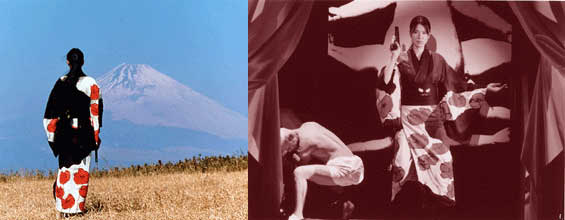Successors to GWG

Non-Narrative Elements
“Killing blooms into a work of art”
(“Pistol Opera”)

“Killing blooms into a work of art”
(“Pistol Opera”)
Costume
Film theory maintains that costuming and narrative situations primarily construct gender. Costume is conceived as an important site of visual pleasure conveying meaning or emotional effects. Recurring patterns of images in settings and costuming provide familiar visual references that serve as a code to distinguish genres. In additional to traditional narrative plot structures, conventional modes of visual representation in costuming have frequently served to undermine or limit the power and effectiveness of women in film. In action films women are seldom positioned to drive the narrative. Conventions of costume help define role and power allocation, while women have frequently also been made the subject of the male gaze by conventions of costume. Costume, particularly for women in film, is therefore an immediately visually salient representation of role, authority and corresponding power.

Musical Score
Of all the cinematic elements, music is the one routinely underutilized in Asian action film. Many of the films reviewed in this essay are, however, distinguished by memorable opening or closing themes or scores. The theme song of the original “Lady Snowblood” (‘Shura no Hana’ – ‘The Flower of Hell’) sung by Meiko Kaji was both beautiful and an efficiently eloquent presentation of “Yuki’s” dilemma. “Princess Blade,” a re-make of “Snowblood,” scored by Kenji Kawai, is set in the near future and closes with an incongruously bouncy J-pop number that ices the cake on the film’s collision of sentiment and mayhem. This, too, seems apposite within the film’s postmodern approach, as does the “Eastern Western” theme of “Gun Crazy” so reminiscent of the Sergio Leone films.


Montage
In cinematic terms, montage refers to contiguity
editing of scenes in such a manner that emotional response to one or both
elements is heightened. The lovemaking scene between “Chin” and “Tok”
in “Fulltime Killer” is edited with alternating scenes of “O” preparing
“Nancy” for burial. With a musical score resembling a metronome,
warm bright lights and the passion of lovemaking contrast with dark blue
shadows and preparation of the dead. This disturbing montage of primal
scenes of life and death is quite effective in deflecting any viewer identification
with “Tok” or “O” at that point in the narrative. Sudden images of
past victims (“Nude Fear”) or past suffering (“Gun Crazy,” “Wild Criminal,”
“Tell Me Something”) evoke pain and invite sympathetic identification.
“Wild Criminal” also uses montage to progress from one symbolic scene (an
assault) to another (a shower) – both of which might separately invite
a sadistic gaze. Yet since their contiguity clearly directs attention
to the pain of violence and undoing by cleansing, opportunities for scopophilic
fetishism are neutralized. Use of montage forces the viewer to confront
both the act and victim from the perspective of the experiencing person
“Yuki” (Miho Nomoto), rather than viewing her as an object. Brief
images of the killer’s fantasy drawings in “Nude Fear” provide a chilling
counterpoint to otherwise routine interactions with a released kidnap victim.
Painful, avoided memories re-emerge as scenes juxtaposed with current action
in “Black Angel,” “Yellow Hair 2” and “H.”
Slow Motion
HK cinema did not invent slow motion but made it its own. By slowing the rate of presentation of narrative elements, the audience is allowed to develop maximal emotional response. Primal life and death moments are slowed and extended in this manner in “Portland Street Blues,” “Nude Fear” and “Fulltime Killer.” The latter film, in particular, involves elements of “bullet ballet” that are distinctive to HK action film. Elements of slow motion are perhaps used with less frequency in Japanese and Korean action films, but are clearly present in “Gun Crazy” as “Saki” (Ryoko Yonekura) repeatedly blasts her way through the opposition with a pair of 9 mm automatics, and during fight sequences of “Princess Blade,” “No Blood No Tears,” and “Yellow Hair 2.” “Resurrection of the Little Match Girl” repeatedly plays with time by speeding and slowing action in knowing parody, further associating its narrative with the limitless possibilities of video gaming. “Black Angel,” “Wild Criminal” and “Score 2” use extreme slow motion to heighten attention and allow emotional response to build during the approach of avenging women. From the perspective of the offender, so to speak, the audience is given additional time to contemplate the awful fate that imminently awaits at the hands of the advancing agent of revenge. It may be noteworthy that this appears most typically characteristic of Japanese titles – to which could be added the extended final standoff of “Gun Crazy.” Slow motion is used in “Portland Street Blues” and “So Close” to emphasis moments of emotional intimacy.
Surrealism
Surrealist cinema seeks striking arrangements of objects or images to create momentarily heightened aesthetic impact. Although largely abandoned by classical Hollywood, surrealist elements have begun to return to Western action cinema in the form of what Ann Marie Seward Barry has termed the “New Violence,” an aesthetically appealing juxtaposition of beautiful imagery and barbaric content. From a Western viewing perspective, Japanese cinema should provide ample opportunities for such imagery, given Japanese cultural emphasis on the ephemeral nature of beauty, the “ah-ness” of a fleeting image or moment. Such elements were abundantly present in “Lady Snowblood,” from “Yuki’s” umbrella filmed from above, her sun-drenched walk beside the ocean, to the bamboo Chikufujin dolls tumbling into the water. Other images are darker. Yuki’s otherworldly austerity when staring at “Banzo” in a bar, her grim blood-spattered face when contemplating the body of “Kitahama Okono,” her own blood in the snow, all involve the juxtaposition of evocative elements – particularly the white of purity and red of sincerity.

